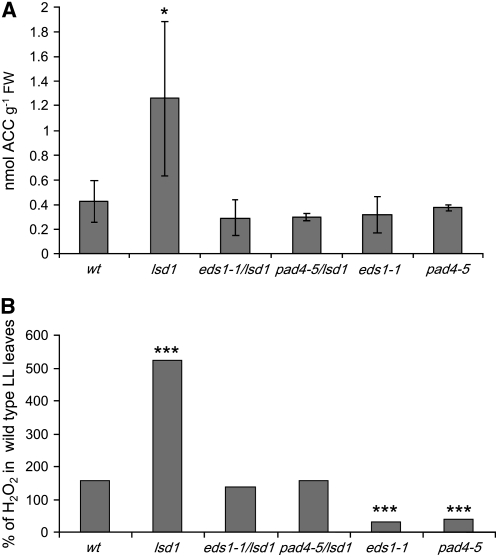Figure 6.
LSD1, EDS1, and PAD4 Control Stress Induced Ethylene and Hydrogen Peroxide Levels in Arabidopsis.
(A) EEE treatment (2000 ± 250 μmol m2 s−1) induces significantly higher production of ACC in Ws-0 lsd1 mutants than in the Ws-0 wild type (Student's t test P < 0.05*, n = 4 ± sd for each treatment). lsd1 mutants produce threefold higher amounts of the ethylene precursor ACC in response to EEE compared with wild-type plants. Therefore, LSD1 is a negative regulator of stress ethylene. Ethylene signaling in the absence of functional LSD1 was positively dependent on EDS1 and PAD4 since eds1-1 lsd1 and pad4-5 lsd1 double mutants reverted to wild-type levels of ACC in EEE and single pad4-4 and eds1-1 mutants could not increase ACC levels. Control levels of ACC in Ws-0 and all mutants vary between 0.15 and 0.24 nmol ± 0.12 sd of ACC per g FW.
(B) EEE treatment induces significantly higher production of H2O2 in Ws lsd1 mutants than in the Ws-0 wild type (Student's t test; ***P < 0.001, n = 4 ± sd for each treatment). The lsd1 mutant produce twofold higher amounts of H2O2 in response to EEE compared with wild-type plants. Therefore, LSD1 is a negative regulator of stress H2O2. H2O2 signaling in absence of functional LSD1 was positively dependent on EDS1 and PAD4 since eds1-1 lsd1 and pad4-5 lsd1 double mutants reverted to wild-type levels of H2O2 levels in EEE, and single pad4-5 and eds1-1 actually had decreased H2O2 levels (Student's t test; ***P < 0.001, n = 4 ±S.D. for each treatment). Control levels of H2O2 in Ws-0 and all mutants were set to 100%

